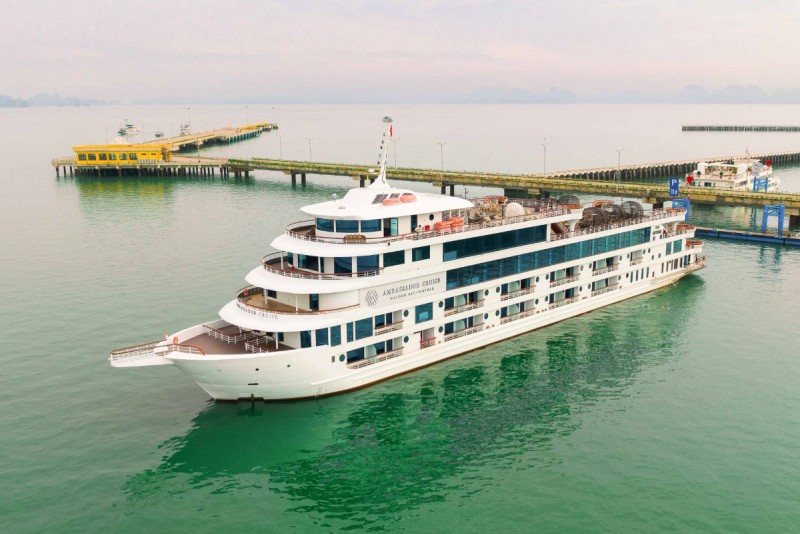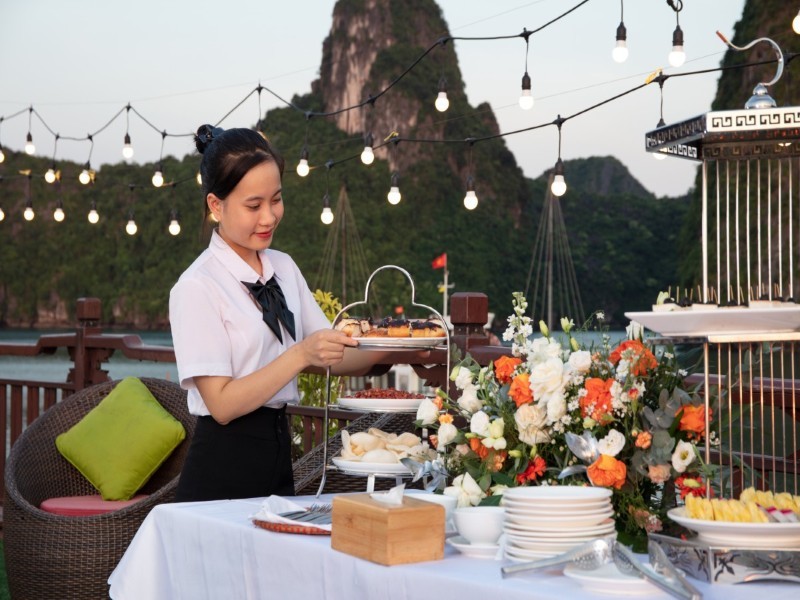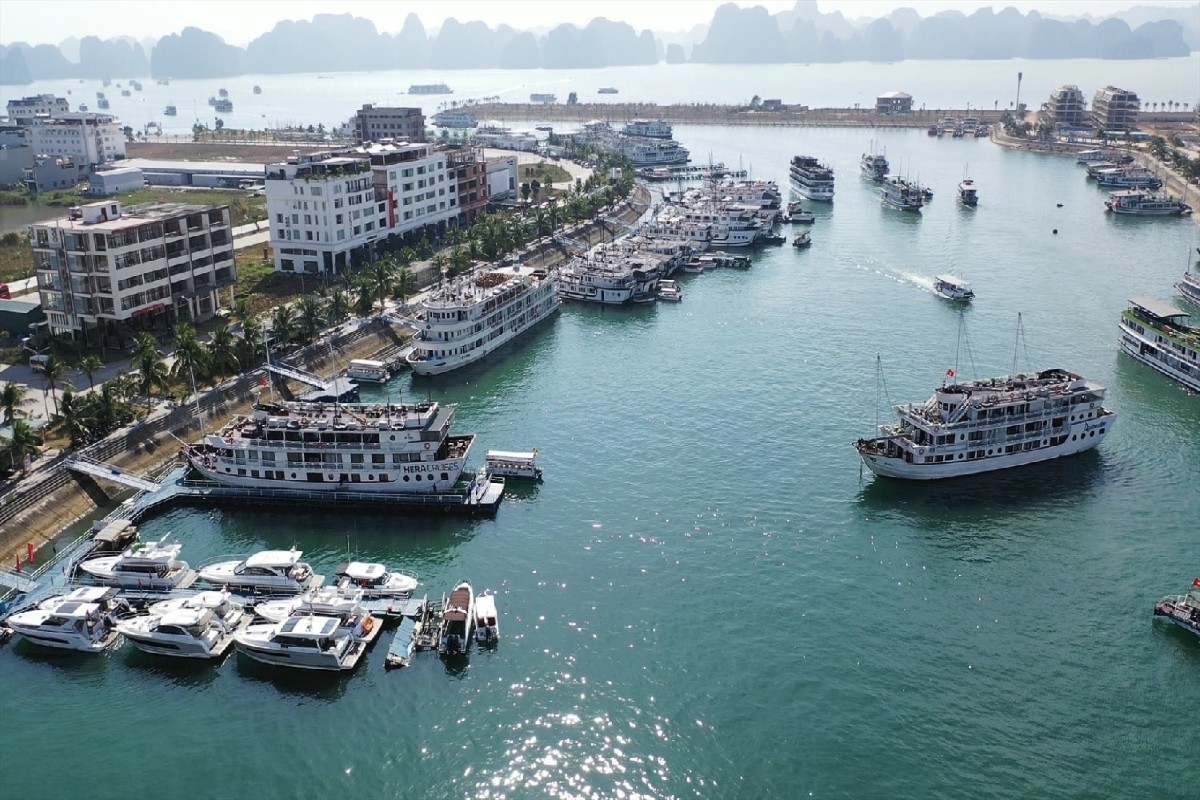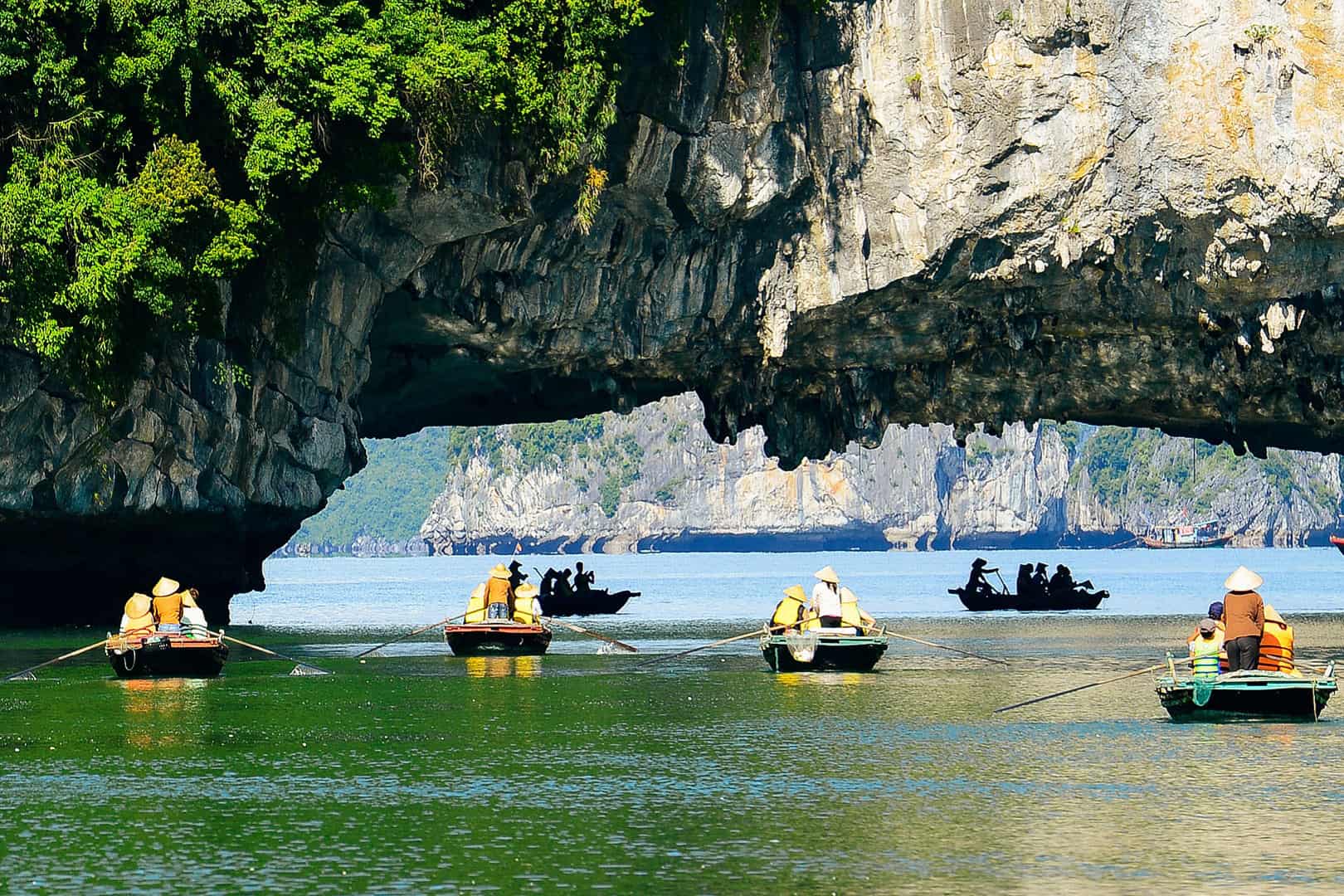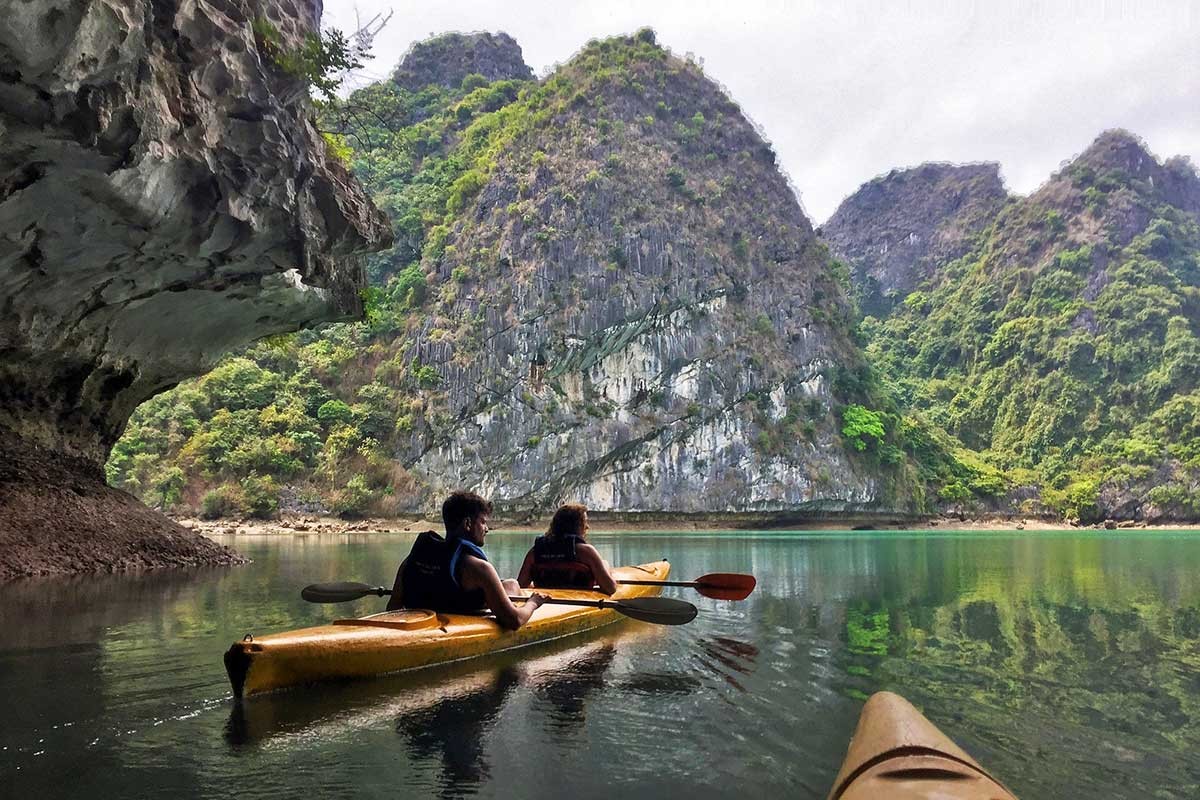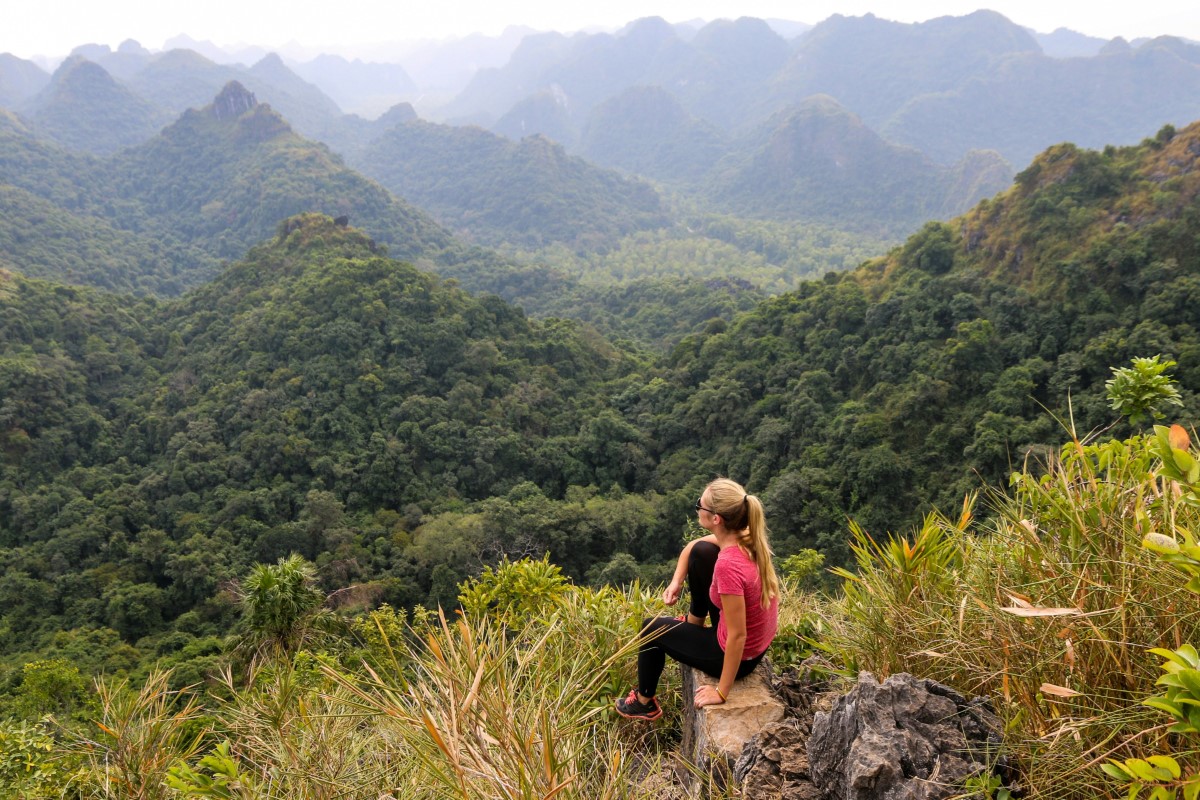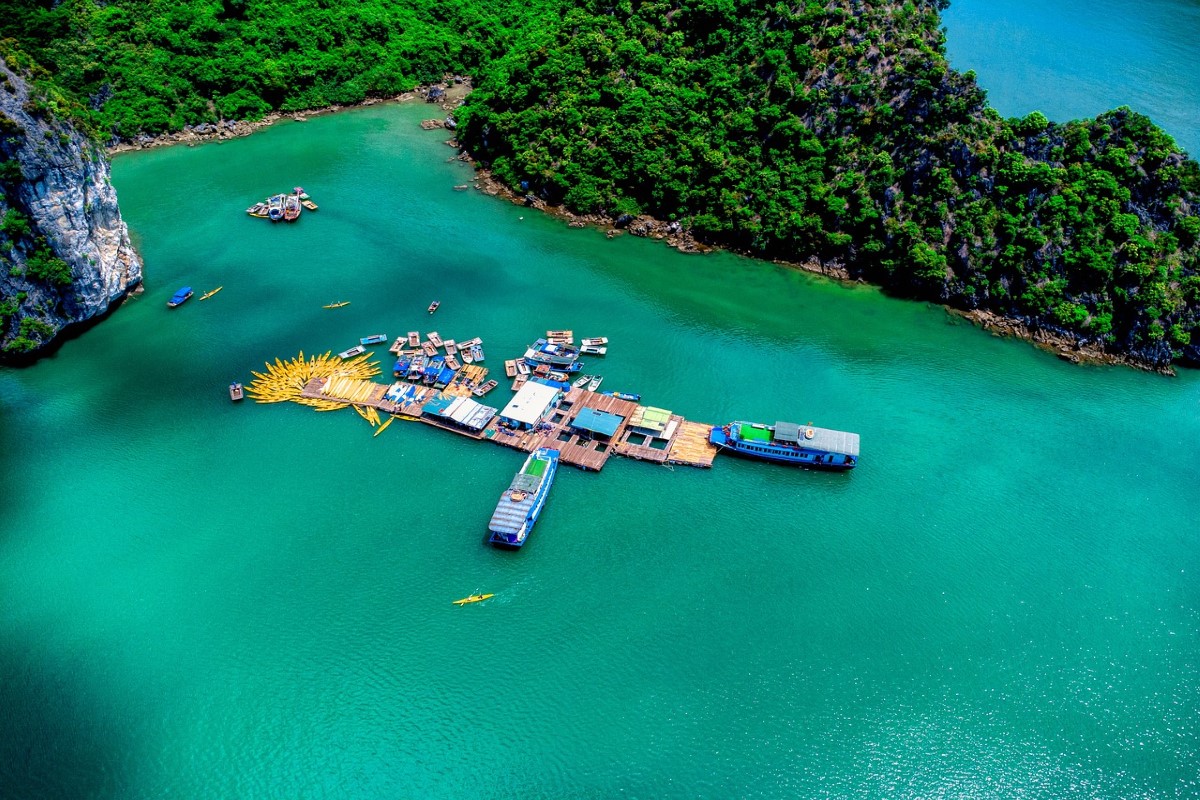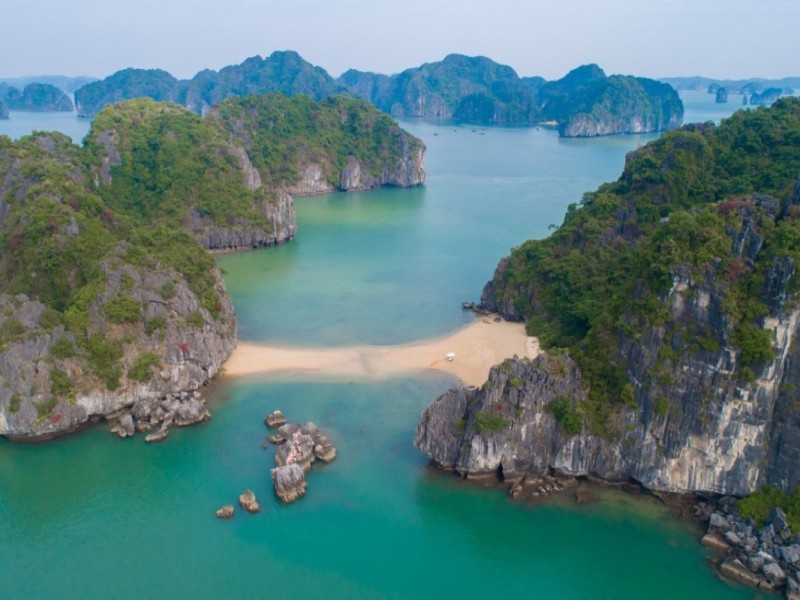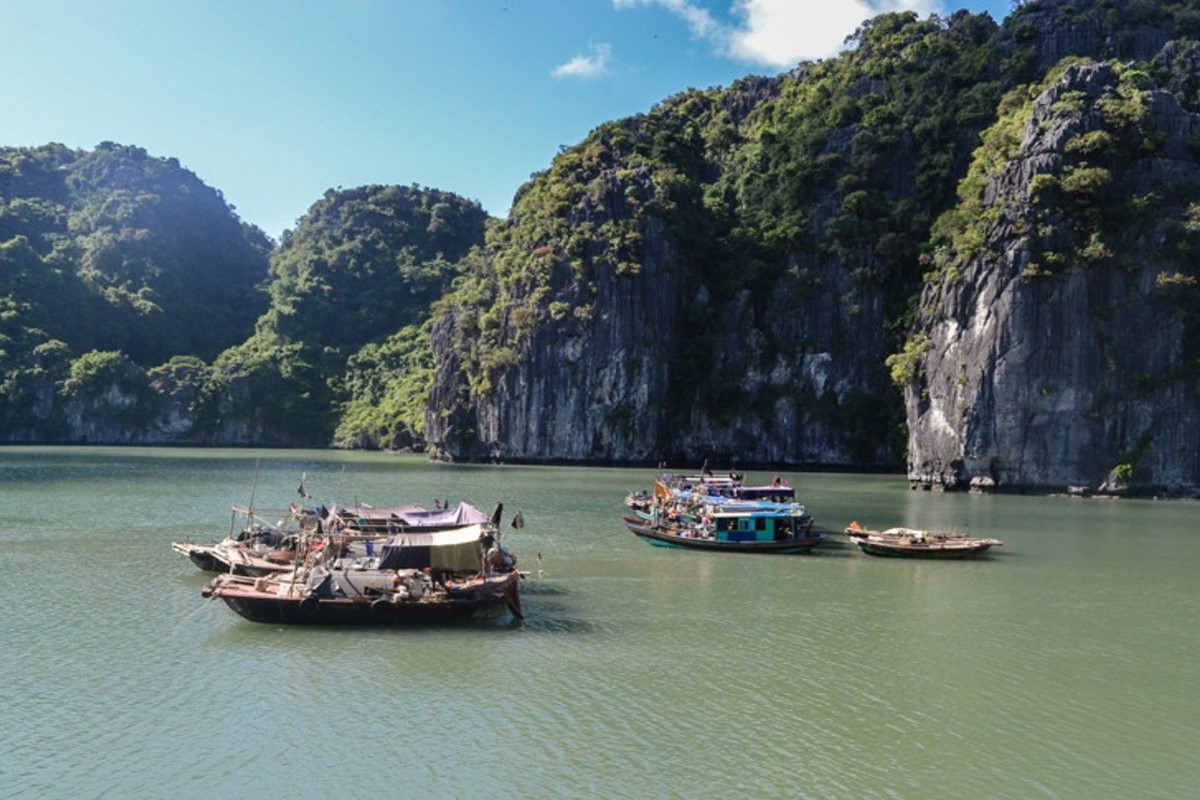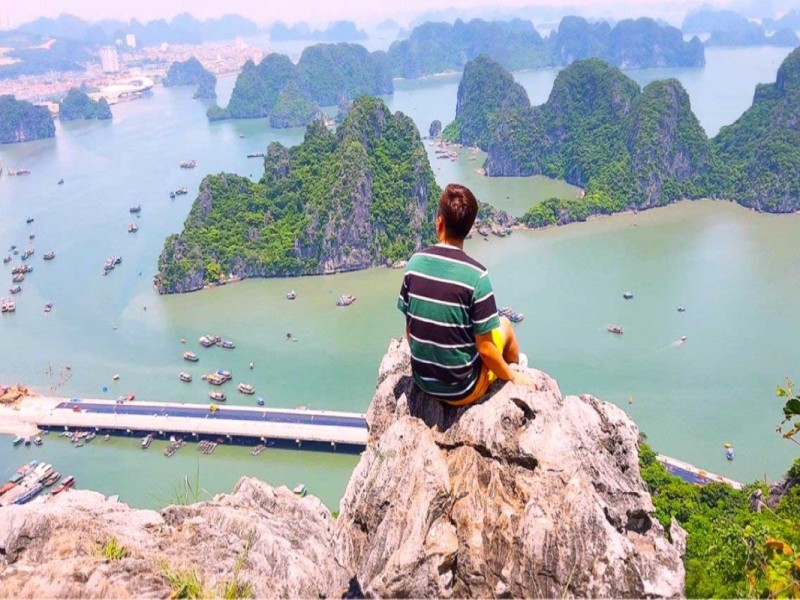Bai Chay Bridge Travel Guide: Vietnam’s Must-Visit Landmark
Bai Chay Bridge, the stunning cable-stayed engineering marvel in Ha Long Bay, is more than just a passage between Hon Gai and Bai Chay—it’s a gateway to Vietnam’s rich history, modern progress, and breathtaking landscapes. Spanning 2,487 meters across the Cua Luc River, the bridge serves as a testament to Vietnam’s contemporary architectural achievements. Visitors flock to this iconic structure not only to marvel at its design but also to experience the panoramic views of Ha Long Bay and its surrounding attractions. Whether you're drawn by its record-breaking structure, dazzling nighttime illumination, or proximity to Ha Long's cultural hotspots, Bai Chay Bridge promises an unforgettable journey.
 Bai Chay Bridge overlooks the scenic coastal landmarks of Quang Ninh, providing breathtaking views of the vibrant Ha Long region.
Bai Chay Bridge overlooks the scenic coastal landmarks of Quang Ninh, providing breathtaking views of the vibrant Ha Long region.
Introduction to Bai Chay Bridge
Nestled amidst the breathtaking landscapes of Ha Long Bay, Bai Chay Bridge stands as a remarkable symbol of Vietnam's modern engineering excellence. This iconic cable-stayed bridge, with its sleek design and record-breaking structure, not only connects the bustling economic hubs of Hon Gai and Bai Chay but also captivates travelers with its artistic brilliance and cultural significance. Spanning 2,487 meters over the Cua Luc River, the bridge is much more than a feat of infrastructure—it’s a gateway to the heart of Quang Ninh Province's vibrant heritage and natural beauty.
What sets Bai Chay Bridge apart is its dual appeal: during the day, its towering pylons and harp-like cables dominate the skyline, embodying strength and elegance. By night, the bridge transforms into a luminous masterpiece, its lights shimmering on the water below, offering an unforgettable view for visitors. Constructed between 2003 and 2006, this architectural marvel not only streamlines travel across Ha Long Bay but also represents the bold spirit of Vietnam's modernization efforts. Whether you're an admirer of groundbreaking architecture or simply seeking a unique perspective on Ha Long Bay landmarks, Bai Chay Bridge promises a journey filled with wonder and discovery.
The Architectural Icon of Ha Long Bay
Towering above the waters of Ha Long Bay, Bai Chay Bridge captivates visitors with its sleek design and strategic importance. Stretching 2,487 meters, it’s the longest cable-stayed bridge of its kind in Vietnam. This architectural masterpiece not only connects two economic hubs—Hon Gai and Bai Chay—but also reflects Vietnam’s dedication to innovation and functionality. From the glistening lights that illuminate its cables at night to its commanding pylon towers, the bridge is a visual spectacle that complements the natural beauty of Ha Long Bay landmarks.
The cable-stayed structure mimics a harp when viewed from above, an artistic representation of harmony and grace. Each design element, from its 90-meter-high towers to its 435-meter central span, speaks of a careful balance between utility and beauty. Whether you're admiring the bridge during the day or captivated by its nighttime glow, Bai Chay’s visual appeal leaves an indelible mark on its visitors.
Historical Background
Constructed between May 2003 and December 2006, Bai Chay Bridge stands as a collaborative effort between Japanese and Vietnamese engineering pioneers. Designed by the Japan Bridge and Structure Institute (JBSI) and built by global leaders like Shimizu and Sumitomo Mitsui, the bridge took over 40 months to complete. Its completion marked a significant milestone, providing a seamless connection across the Cua Luc River, streamlining transportation, and bolstering Ha Long’s tourism economy.
The bridge’s history is a tale of resilience and ambition. Engineers faced challenges in creating a structure that could withstand the region’s volatile weather conditions, including earthquakes and typhoons. The use of pre-stressed concrete box girders - a groundbreaking technique at the time - set Bai Chay apart, earning it a world record for its central span.
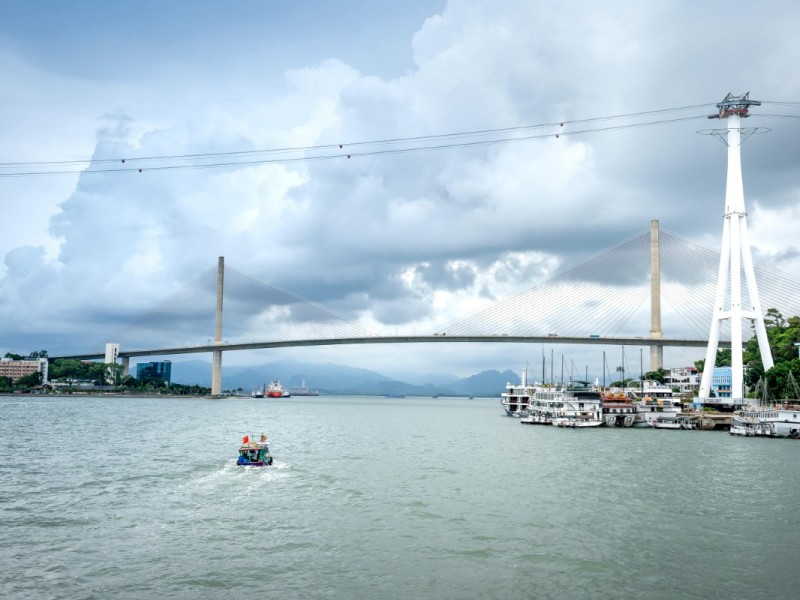 Bai Chay Bridge spans Halong Bay, showcasing Vietnam’s modern engineering and providing stunning vistas of the bay and surrounding landmarks.
Bai Chay Bridge spans Halong Bay, showcasing Vietnam’s modern engineering and providing stunning vistas of the bay and surrounding landmarks.
Why Visit Bai Chay Bridge?
Visiting Bai Chay Bridge is more than just a trip to an architectural wonder—it's an experience that combines history, culture, and nature in one stunning destination. As the longest cable-stayed bridge in Vietnam, Bai Chay seamlessly blends modern engineering with the natural splendor of Ha Long Bay, offering breathtaking views, especially during sunrise and sunset. Whether you're drawn by its record-breaking design, the allure of its illuminated beauty at night, or its role as a gateway to nearby attractions, the bridge offers a unique perspective of Vietnam’s evolving landscape. Perfect for photographers, history enthusiasts, and adventurers, Bai Chay Bridge is a must-visit landmark that captivates every type of traveler.
Scenic Views and Nighttime Beauty
There’s a unique charm to Bai Chay Bridge that’s best experienced under the evening sky. As the sun sets over Ha Long Bay, the bridge comes alive with a kaleidoscope of lights, creating a mesmerizing reflection on the waters below. Photographers, both amateur and professional, find themselves drawn to this vantage point, where the bridge’s illuminated cables stretch like glowing strings of a harp.
During the day, the bridge offers panoramic views of Ha Long’s sprawling coastlines and nearby islands. For travelers looking to capture the essence of scenic spots in Ha Long, Bai Chay Bridge provides the perfect blend of modernity and natural beauty.
Gateway to Ha Long’s Attractions
Beyond its architectural brilliance, Bai Chay Bridge serves as a pivotal gateway to some of Ha Long’s most cherished destinations. On one side lies Hon Gai, known for its cultural landmarks like the Quang Ninh Museum, while the other side opens to Bai Chay, a bustling area featuring Vietnam’s largest artificial beach. The bridge’s strategic location makes it a central hub for travelers exploring the best places near Bai Chay Bridge.
Tourists can easily transition from the serene landscapes of Hon Gai to the vibrant activities of Bai Chay’s night markets and sandy shores. This dual experience of tranquility and excitement makes the bridge more than a structure—it’s a passage to Vietnam’s diverse offerings.
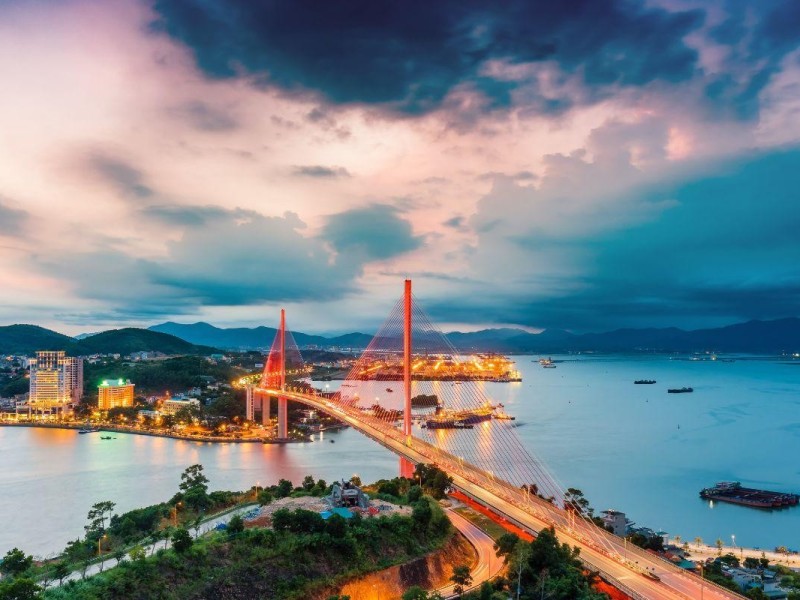 The illuminated Bai Chay Bridge offers a stunning nighttime view, blending modern architecture with the natural beauty of Halong Bay.
The illuminated Bai Chay Bridge offers a stunning nighttime view, blending modern architecture with the natural beauty of Halong Bay.
Facts About Bai Chay Bridge
Behind the awe-inspiring facade of Bai Chay Bridge lies a story of engineering innovation and meticulous craftsmanship. Stretching 2,487 meters over the Cua Luc River, this record-breaking bridge was built to withstand the region’s challenging weather conditions, including typhoons and earthquakes. Its central span of 435 meters, constructed with pre-stressed concrete box girders, sets a global benchmark in bridge design. The towering pylons and wide deck not only ensure durability but also reflect Vietnam’s rise as a leader in modern infrastructure. Exploring these fascinating facts about Bai Chay Bridge deepens your appreciation for this masterpiece that connects the past and future of Vietnamese engineering.
Record-Breaking Design
Bai Chay Bridge holds a prestigious world record for its innovative engineering, boasting a central span of 435 meters constructed with pre-stressed concrete box girders—a groundbreaking technique at the time of its design. This engineering feat solidified the bridge's place on the global stage, as it surpassed many other renowned structures in design complexity and scale.
When compared to other globally recognized cable-stayed bridges, such as France’s Elom Bridge (400 meters) or the Sunshine Skyway Bridge in the United States (366 meters), Bai Chay emerges as a testament to Vietnam’s modern bridges and engineering capabilities. Its sleek design not only embodies functional brilliance but also enhances the aesthetic appeal of Ha Long Bay. The use of cutting-edge technology and high-grade materials set new benchmarks for bridge construction in Asia, making it an inspiration for future infrastructure projects worldwide.
For travelers, standing on Bai Chay Bridge offers a unique perspective—not just of the breathtaking surroundings but also of the immense creativity and innovation that went into its construction. It’s a visual and structural masterpiece that highlights Vietnam’s progression into the realm of modern architecture.
Engineering and Resilience
Bai Chay Bridge was built to endure. Designed to withstand earthquakes of up to magnitude 7, typhoon-force winds of 180 kilometers per hour, and temperature fluctuations, the bridge exemplifies resilience. This level of structural fortitude is crucial given Ha Long Bay’s challenging weather conditions.
The bridge’s impressive specifications include 90-meter-tall pylons, a navigational clearance of 50 meters, and a robust deck width of 25.5 meters, which accommodates four vehicle lanes and two pedestrian lanes. Engineers incorporated advanced resilient bridge designs to ensure the structure could handle the daily movement of vehicles and pedestrians while enduring the environmental stresses of coastal Vietnam.
Its resilience isn’t just technical—it’s symbolic. Bai Chay Bridge represents Vietnam’s determination to connect communities and advance its infrastructure, proving its capability to execute projects of such scale and complexity. Travelers can walk along the pedestrian pathways, marveling at the towering pylons and understanding how human ingenuity merged with nature to create a bridge that’s as strong as it is beautiful.
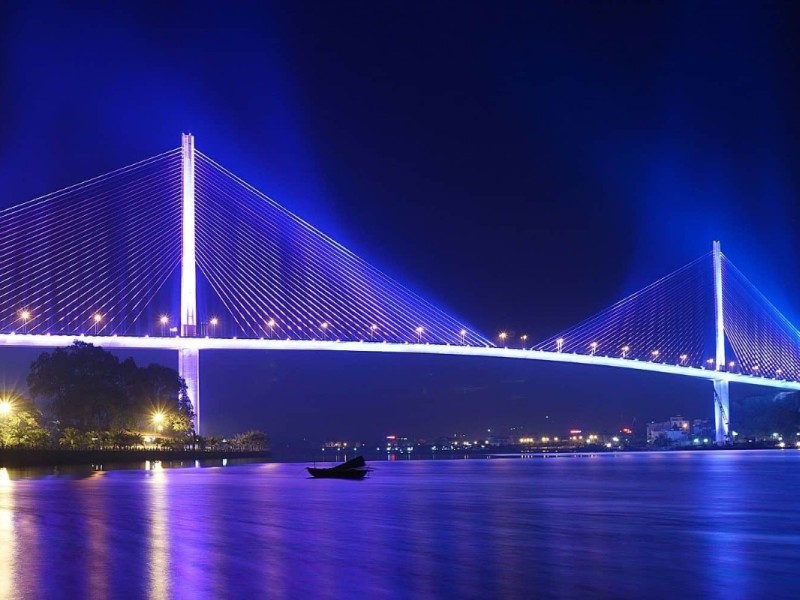 Bai Chay Bridge transforms into a glowing masterpiece at night, with its stunning lights illuminating Halong Bay’s serene waters.
Bai Chay Bridge transforms into a glowing masterpiece at night, with its stunning lights illuminating Halong Bay’s serene waters.
Nearby Attractions and Activities
Bai Chay Bridge is not just a destination in itself but a gateway to an array of cultural landmarks and activities in Ha Long Bay. From the tranquil Hon Gai Beach to the architecturally stunning Quang Ninh Museum, the bridge connects you to some of the region’s most cherished attractions. On the southern end lies Bai Chay Beach, a hotspot for relaxation and water activities, complemented by the vibrant Bai Chay Night Market, where you can immerse yourself in local flavors and crafts. Whether you’re seeking serene landscapes, cultural enrichment, or lively adventures, the attractions around Bai Chay Bridge promise an itinerary filled with discovery and delight.
Hon Gai Highlights
Just a stone’s throw from Bai Chay Bridge, the Hon Gai area is a treasure trove of cultural landmarks and family-friendly destinations. Known for its serene atmosphere, Hon Gai Beach offers visitors a chance to unwind amidst crystal-clear waters and soft sands. Families often flock here for picnics and relaxation, as the beach provides a peaceful retreat from the bustling city.
A short walk away, the Quang Ninh Museum invites history and art enthusiasts to delve deeper into the cultural heritage of the region. This striking building, with its black glass façade resembling a giant mirror, houses exhibits ranging from ancient artifacts to contemporary art pieces. It’s a destination that offers something for everyone, from children learning about their heritage to adults seeking a deeper appreciation of Vietnam’s rich history.
Accessible via both public transport and private vehicles, Hon Gai is a convenient and captivating stop for anyone exploring Quang Ninh attractions. Its quiet charm and historical richness make it a perfect counterpart to the modern, dynamic Bai Chay area.
Bai Chay Activities
On the southern end of Bai Chay Bridge lies the vibrant Bai Chay area, renowned for its artificial beach and bustling night market. Spanning 1,000 meters, Bai Chay Beach is a hotspot for water sports, sunbathing, and leisurely walks along the shoreline. The clear blue waters and well-maintained facilities make it an ideal spot for families, couples, and solo travelers alike.
As evening falls, the Bai Chay Night Market comes alive with the sights, sounds, and smells of local culture. Vendors line the market streets, offering everything from handcrafted souvenirs to fresh seafood delicacies. Visitors can sample authentic dishes like grilled squid and steamed clams, or shop for unique trinkets that capture the essence of Ha Long Bay.
For those planning to explore the market, it’s best to arrive early to avoid the crowds and secure the freshest seafood. Travelers are also encouraged to bring cash, as many vendors prefer it over card payments. The best activities near Bai Chay combine the thrill of discovery with the charm of local traditions, making it a must-visit destination for those staying in Ha Long Bay.
 Experience the stunning architecture of Bai Chay Bridge, a landmark connecting Hon Gai and Bai Chay with breathtaking views of Halong Bay.
Experience the stunning architecture of Bai Chay Bridge, a landmark connecting Hon Gai and Bai Chay with breathtaking views of Halong Bay.
Creating Lasting Memories at Bai Chay Bridge
Bai Chay Bridge is more than a feat of engineering—it’s a canvas for unforgettable memories. Couples can soak in the romantic ambiance of the illuminated bridge at night or enjoy breathtaking sunsets that paint the skies over Ha Long Bay. Families will find joy in leisurely walks across the bridge, marveling at its design, or exploring nearby beaches and markets that offer activities for all ages. Each moment spent at Bai Chay Bridge becomes a memory to cherish, whether you’re taking a quiet stroll under its glowing lights or capturing its beauty through the lens of a camera.
Romantic Experiences
There’s a certain magic to Bai Chay Bridge that comes alive as the day transitions to night. Couples seeking a romantic getaway in Ha Long Bay will find the perfect setting here, where the glowing lights of the bridge reflect on the still waters below, creating a scene of tranquility and allure.
During sunset, the bridge offers a front-row seat to one of the most stunning natural spectacles in Vietnam. The fiery hues of orange and pink blend seamlessly with the serene blues of Ha Long Bay, painting the sky and water in breathtaking harmony. Whether it’s a quiet walk hand-in-hand across the pedestrian lanes or sitting on a nearby bench to soak in the views, sunset at Bai Chay Bridge is a moment to cherish.
As darkness falls, the bridge transforms into a luminous masterpiece. The intricate lighting system highlights its harp-like cables, casting a romantic glow over the surroundings. For couples, this ambiance offers an unforgettable backdrop for proposals, anniversaries, or simply a peaceful evening together. Bai Chay Bridge stands out as one of the most romantic getaways in Ha Long Bay, blending modernity with the timeless beauty of nature.
Family-Friendly Adventures
Bai Chay Bridge isn’t just a destination for couples—it’s a haven for families as well. The wide pedestrian pathways are perfect for children to explore safely, offering plenty of room for strollers and young walkers. Families can embark on a leisurely walking tour of the bridge, taking in its scenic views and learning about its architectural marvels.
A short trip from the bridge leads to Bai Chay Beach, where children can play in the sand, build castles, or splash in the calm waters. Nearby family-friendly restaurants and cafes ensure parents can relax while keeping an eye on the little ones.
For a more structured adventure, parents can plan visits to the Quang Ninh Museum in Hon Gai or the bustling Bai Chay Night Market, both of which offer kid-friendly activities. To ensure a safe and enjoyable trip, it’s advisable to visit during early morning or late afternoon to avoid the midday heat and carry plenty of water. These thoughtful tips, combined with the bridge’s accessible design, make it one of the best places for kids in Ha Long Bay.
Unique Features of Bai Chay Bridge
The distinctive charm of Bai Chay Bridge lies in its unique features that set it apart from other landmarks. Its harp-like design, created by the vertical suspension cables, symbolizes harmony and grace, making it not just a bridge but a work of art. Standing atop the bridge offers panoramic views of Ha Long Bay, where the rugged cliffs, shimmering waters, and distant islands come together to create a scene of unparalleled beauty. Whether it’s the cultural significance of its design or the seasonal changes in the surrounding scenery, Bai Chay Bridge offers an experience that is as unique as it is captivating.
The Harp-Like Design
One of the most captivating aspects of Bai Chay Bridge is its resemblance to a colossal harp. The vertical cables that suspend the bridge deck create an image of harmony and elegance, as if strummed by the gentle winds of Ha Long Bay. This unique design is not only a testament to architectural ingenuity but also a symbol of cultural significance, representing the bridge as a unifying link between two vibrant communities.
Viewed from above, the bridge’s sweeping curves and taut cables mimic the strings of a harp, blending seamlessly with the natural landscape. Its artistic brilliance has made it a cultural landmark in Vietnam, drawing both engineers and artists to study its design. For visitors, walking along the bridge feels like stepping into a living piece of art, where modernity meets tradition in perfect harmony.
Views of Ha Long Bay
The panoramic views from Bai Chay Bridge are unmatched, offering travelers a vantage point like no other in Ha Long Bay. To the north, the rugged cliffs of Hon Gai rise majestically, while to the south, the expansive Bai Chay Beach stretches out, inviting exploration. As the tides shift, the scenery changes dramatically, showcasing the natural beauty of the bay in different lights.
Each season brings its own charm. In spring, the lush greenery of surrounding hills creates a vivid contrast against the turquoise waters. Summer offers vibrant skies, while autumn’s golden hues and winter’s misty mornings add a mystical touch to the landscape. No matter the time of year, the scenic views of Bai Chay Bridge promise a feast for the eyes and an opportunity for stunning photography.
Visitors often linger on the bridge to watch fishing boats glide silently beneath or to spot distant islands shimmering on the horizon. The serene environment encourages contemplation, making it a must-visit for nature lovers and photographers alike. For those planning a visit, early morning and late afternoon are ideal times to capture the best light and avoid crowds, especially during peak tourist seasons.
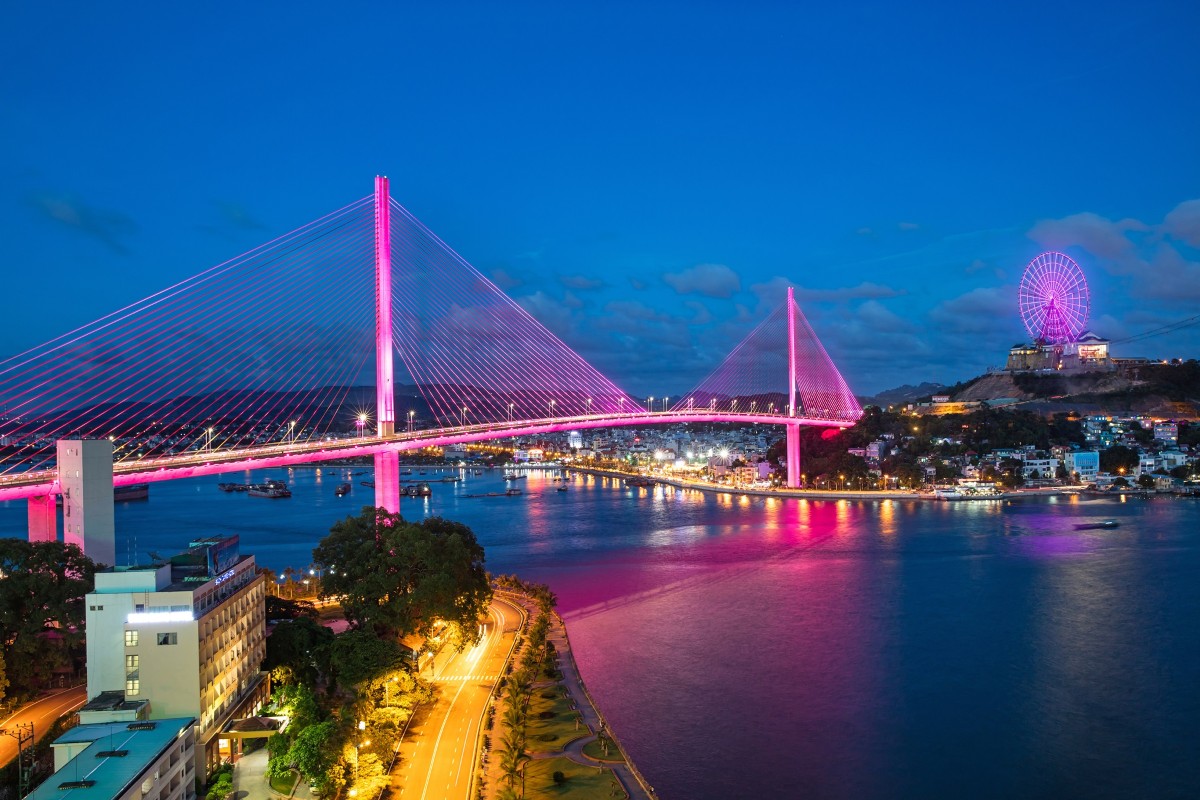
Planning Your Visit to Bai Chay Bridge
A visit to Bai Chay Bridge is as much about the journey as the destination. Situated in the heart of Ha Long Bay, the bridge is easily accessible from Hanoi and other nearby cities, making it a perfect addition to any travel itinerary. With multiple options for travel, including car, bus, and train, visitors can choose the route that best fits their schedule and budget. To make the most of your trip, plan around the best times to visit, such as early mornings or late afternoons, when the lighting is ideal for photography and the weather is most comfortable. Bai Chay Bridge is not just a stop—it’s the start of an adventure.
How to Get There
Reaching Bai Chay Bridge from Hanoi is straightforward, with several convenient options tailored to suit different travel preferences. Located approximately 165 kilometers from Vietnam’s capital, the journey offers scenic routes through the vibrant countryside of Quang Ninh Province.
By Car:
Traveling by car is the most flexible option. A private vehicle or taxi allows visitors to stop at picturesque spots along the way, turning the trip into a mini-adventure. The drive takes approximately 3–4 hours, depending on traffic, with the newly constructed Hanoi-Haiphong Expressway providing a smooth and direct route to Ha Long Bay.
By Bus:
Buses offer an affordable and comfortable alternative. Numerous operators, such as Kumho Viet Thanh and Phuc Xuyen, provide daily services from Hanoi to Ha Long City. Most buses depart from My Dinh Bus Station, and tickets can be booked online or at the station. The trip typically takes 3.5–4 hours.
By Train:
For a leisurely and scenic journey, travelers can take the train. While slightly slower, the rail route allows passengers to enjoy Vietnam’s lush landscapes. The train ride to Ha Long City takes around 5 hours, making it ideal for those who value the journey as much as the destination.
Best Times to Visit:
The best time to explore Bai Chay Bridge is during early mornings or late afternoons. These hours provide the perfect lighting for photography and a more comfortable climate, especially during summer months. Seasonal considerations include spring (March–April) and autumn (September–November), when the weather is mild and the scenery vibrant.
Guided Tours and Activities
For a truly immersive experience, booking a guided tour of Bai Chay Bridge is highly recommended. Professional guides provide fascinating insights into the bridge’s history, design, and cultural significance, enriching your visit with context that might otherwise go unnoticed.
Photography tours are particularly popular among travelers, offering expert tips on capturing the bridge’s iconic design, whether at sunset or under its dazzling nighttime illumination. For those interested in history and culture, guided walks around nearby attractions, such as the Quang Ninh Museum and Hon Gai Beach, offer a deeper understanding of the region’s heritage.
To ensure a seamless experience, it’s best to book tours in advance, especially during peak travel seasons. Many operators provide customizable itineraries, allowing you to combine the bridge visit with other highlights of Quang Ninh.
Practical Tips for Travelers
Preparing for your visit to Bai Chay Bridge can enhance your experience and help you make the most of this iconic destination. The bridge features wide, pedestrian-friendly pathways, perfect for walkers, families, and solo travelers alike. For those driving, parking facilities are available nearby, and public transport options provide easy access to the bridge from Ha Long City. Plan your visit during spring or autumn for the most comfortable weather, and keep an eye out for local festivals that add cultural vibrancy to the experience. From packing essentials for a family trip to finding accommodations near the bridge, these practical tips ensure a smooth and enjoyable visit to Bai Chay Bridge.
Best Times to Visit
The timing of your visit to Bai Chay Bridge can significantly enhance your experience. Each season offers unique advantages:
- Spring (March–April): The surrounding landscapes are lush and vibrant, with mild temperatures perfect for outdoor activities.
- Summer (June–August): While the weather can be warmer, the clear skies make it an ideal time for photography and enjoying nearby beaches.
- Autumn (September–November): Cooler breezes and golden foliage add a picturesque charm to the area, making it a favorite for nature lovers.
- Winter (December–February): Misty mornings and serene views give the bridge a mystical quality, although the cooler temperatures require warmer clothing.
Additionally, Ha Long Bay hosts various festivals throughout the year, such as the Carnaval Ha Long in April, which features vibrant parades and cultural performances. Attending these events can elevate your trip, offering a blend of architectural marvels and local traditions.
Essential Visitor Information
To ensure a hassle-free visit, travelers should familiarize themselves with the amenities and services available at Bai Chay Bridge:
- Parking: Secure parking facilities are available near the bridge, making it easy for those traveling by car.
- Accessibility: The pedestrian lanes are wide and well-maintained, accommodating strollers and wheelchairs, ensuring the bridge is accessible to all.
- Nearby Accommodations: Several hotels and guesthouses in the Bai Chay area cater to different budgets. Popular options include beachfront resorts and boutique hotels offering stunning views of Ha Long Bay.
- Tips for Families and Solo Travelers: Families should pack essentials such as snacks and water for children, especially if planning extended walks on the bridge. Solo travelers can take advantage of guided tours to learn more about the bridge’s history and connect with fellow tourists.
By planning ahead and considering these practical details, visitors can maximize their time at Bai Chay Bridge, ensuring a memorable and enjoyable experience.
Final Thoughts on Bai Chay Bridge
Bai Chay Bridge is more than just an architectural wonder—it’s a gateway to the heart of Ha Long Bay, connecting travelers to the region’s cultural richness and natural beauty. From its record-breaking design to its breathtaking views, the bridge offers something for everyone, whether you’re a couple seeking a romantic sunset, a family exploring the area’s attractions, or a solo traveler marveling at its engineering brilliance.
By combining historical significance, modern innovation, and easy accessibility, Bai Chay Bridge stands out as one of the must-visit places in Ha Long. Its luminous presence at night, combined with nearby activities and attractions, makes it a destination worth exploring.
Don’t miss the opportunity to walk across this iconic bridge, admire the panoramic views, and immerse yourself in the vibrant culture of Quang Ninh. Make your journey memorable—book your trip to Bai Chay Bridge today and discover one of Vietnam’s most captivating landmarks.
Mike Nguyen
Travel Advisor
Mobile: +84917506881 (whatsapp available)
Email: contact@asiatravellinks.com



